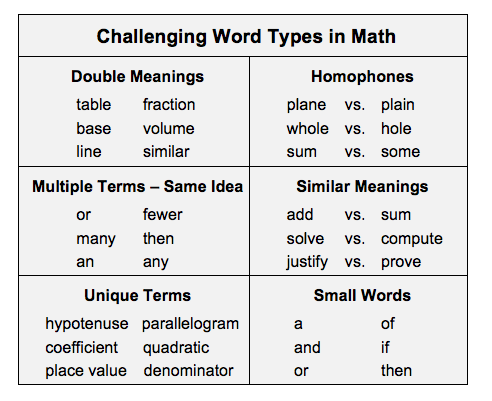To define fraction a student must demonstrate understanding of the mathematical idea of a fraction. An example of a vocabulary activity for the term fraction is the use of a Frayer Model (Frayer, Frederick, & Klausmeier, 1969). The Frayer Model diagram shown to the right illustrates how the understanding of fraction is deepened, reinforced and/or developed as a student creates and completes this chart.
Students should also be required to use specific math vocabulary both orally and in writing beyond vocabulary-specific activities. The California Department of Education finds that teaching math vocabulary in context is “essential for instruction” and goes on to provide an excellent set of recommendations (2015, p. 685).
- Explicitly teach academic vocabulary for mathematics, and structure activities in which students regularly employ key mathematical terms. Be aware of words that have multiple meanings (such as root, plane, table, and so forth).
- Provide communication guides, sometimes called sentence frames, as a temporary scaffold to help students express themselves not just in complete sentences but articulately within the MP standards.
- Use graphic organizers and visuals to help students understand mathematical processes and vocabulary.
Mathematical Language Routines (MLRs) (Zwiers et al., 2017) are an excellent set of evidence-based techniques to assist students with math discourse and with understanding and solving math word problems. The eight MLRs are designed for high levels of student engagement with mathematics texts and discussions. Teachers need to implement techniques that are explicitly designed to assist students in understanding the language of mathematics.
Conclusion
Attention to math vocabulary is an essential part of math instruction. Attention must be given to the variety of challenges students face when learning and using the language of mathematics, such as, math specific words, words with multiple meanings, small words, and semantic challenges (for example, long dense noun phrases). Teachers must explicitly draw attention to mathematical terms as they arise throughout instruction by illustrating the meaning of the terms, helping students associate images with terms (Marzano et al., 2001) and providing constant reinforcement. Teachers can further improve learning by implementing other evidence-based techniques, such as the eight Mathematical Language Routines. Teachers need to keep in mind that math vocabulary goes hand-in-hand with math concepts. Learning math vocabulary in meaningful ways increases students’ learning of mathematics.
Bibliography
Braselton, S., & Decker, B. (1994, November). Using graphic organizers to improve the reading of mathematics. The Reading Teacher, 48(3), 276-281.
Brummer, T., & Kartchner Clark, S. (2014). Writing Strategies for Mathematics. Huntington Beach, CA: Shell Education Publishing Inc.
California Department of Education. (2015). Mathematics Framework for California Public Schools: Kindergarten Through Grade Twelve (pp. 661-697). Sacramento, CA: Author. Retrieved from http://www.cde.ca.gov/ci/ma/cf/mathfwchapters.asp
Fogelberg, E., Skalinder, C., Satz, P., Hiller, B., Bernstein, L., & Vitantonio, S. (2008). Integrating Literacy and Math Strategies for Kñ6 Teachers. New York, NY: The Guilford Press.
Frayer, D. A., Frederick, W. C., & Klausmeier, H. G. (1969, April). A schema for testing the level of concept mastery [Editorial]. Working Paper No. 16.
Hattie, J., Fisher, D., & Frey, N. (2017). Visible Learning for Mathematics. Thousand Oaks, CA: Corwin.
Honig, B., Diamond, L., & Gutlohn, L. (2013). Teaching Reading Sourcebook (2nd ed.). Novato, CA: Arena Press.
Kenney, J. M., Hancewicz, E., Heuer, L., Metsisto, D., & Tuttle, C. L. (2005). Literacy Strategies for Improving Mathematics Instruction. Alexandria, VA: Association for Supervision and Curriculum Development.
Kinsella, K. (2017, March). Helping Academic English Learners Develop Productive Word Knowledge. Language Magazine, 16(7), 24-29.
Marzano, R. J., Pickering, D. J., & Pollock, J. E. (2001). Classroom Instruction that Works(pp. 74-83). Upper Saddle River, NJ: Pearson Education Inc.
National Council of Teachers of Mathematics. (2014). Principles to Actions Ensuring Mathematical Success for All. Reston, VA: Author.
National Governors Association Center for Best Practices & Council of Chief State School Officers. (2010). Common Core State Standards for Mathematics. Washington, DC: Authors.
National Research Council. (2001). Adding It Up: Helping Children Learn Mathematics. Washington, DC: National Academy Press.
Schleppegrell, M. J. (2007, February 24). The Linguistic Challenges of Mathematics Teaching and Learning: A Research Review. Reading & Writing Quarterly, 23(2), 139-159.
Schleppegrell, M. J. (2010). Language in Mathematics Teaching and Learning: A Research Review. In J. N. Moschkovich (Ed.), Language and Mathematics Education (pp. 73-112). Charlotte, NC: Information Age Publishing, Inc.
Smith, M. S., & Stein, M. K. (2011). Five Practices for Orchestrating Productive Mathematics Discussions. Reston, VA: National Council of Teachers of Mathematics.
Zwiers, J., Dieckmann, J., Rutherford-Quach, S., Daro, V., Skarin, R., Weiss, S., & Malamut, J. (2017) Principles for the Design of Mathematics Curricula: Promoting Language and Content Development, Stanford, CA: Understanding Language/Stanford Center for Assessment, Learning, and Equity. Retrieved from https://ell.stanford.edu/sites/default/files/u6232/ULSCALE_ToA_Principles_MLRs__Final_v2.0_030217.pdf




